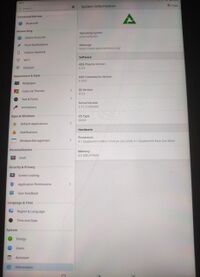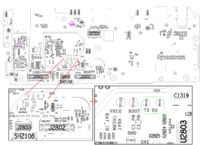Xiaomi Mi Pad 4 (xiaomi-clover)
 Mi Pad 4 PLUS running Plasma Mobile | |
| Manufacturer | Xiaomi |
|---|---|
| Name | Mi Pad 4 |
| Codename | xiaomi-clover |
| Released | 2018 |
| Type | tablet |
| Hardware | |
| Chipset | Qualcomm Snapdragon 660 (SDM660) |
| CPU |
4x Qualcomm Kryo 260 Silver @ 1.8GHz 4x Qualcomm Kryo 260 Gold @ 2.2GHz |
| GPU | Adreno 512 |
| Display | 1920x1200 IPS |
| Storage | 32GB |
| Memory | 3GB |
| Architecture | aarch64 |
| Software | |
Original software The software and version the device was shipped with. |
Android 8 |
Extended version The most recent supported version from the manufacturer. |
Android |
| FOSS bootloader | partial |
| postmarketOS | |
| Category | testing |
Mainline Instead of a Linux kernel fork, it is possible to run (Close to) Mainline. |
yes |
pmOS kernel The kernel version that runs on the device's port. |
6.13 |
| Device package |
|
| Kernel package |
|
Flashing Whether it is possible to flash the device with pmbootstrap flasher. |
Works
|
|---|---|
USB Networking After connecting the device with USB to your PC, you can connect to it via telnet (initramfs) or SSH (booted system). |
Works
|
Internal storage eMMC, SD cards, UFS... |
Works
|
SD card Also includes other external storage cards. |
Works
|
Battery Whether charging and battery level reporting work. |
Works
|
Screen Whether the display works; ideally with sleep mode and brightness control. |
Works
|
Touchscreen |
Works
|
| Multimedia | |
3D Acceleration |
Works
|
Audio Audio playback, microphone, headset and buttons. |
Partial
|
Camera |
Broken
|
Camera Flash |
Broken
|
| Connectivity | |
WiFi |
Partial
|
Bluetooth |
Works
|
GPS |
Broken
|
| Modem | |
Calls |
Broken
|
SMS |
Broken
|
Mobile data |
Broken
|
| Miscellaneous | |
FDE Full disk encryption and unlocking with unl0kr. |
Works
|
USB OTG USB On-The-Go or USB-C Role switching. |
Broken
|
| Sensors | |
Accelerometer Handles automatic screen rotation in many interfaces. |
Works
|
Magnetometer Sensor to measure the Earth's magnetism |
Broken
|
Ambient Light Measures the light level; used for automatic screen dimming in many interfaces. |
Broken
|
Proximity |
Broken
|
Hall Effect Measures magnetic fields; usually used as a flip cover sensor |
Broken
|
Haptics |
Works
|
Primary Bootloader Whether it is possible to replace stock bootloader with U-Boot. |
Broken
|
|---|---|
Secondary Bootloader Whether it is possible to chainload U-Boot from stock bootloader. |
Works
|
Mainline Whether latest upstream versions of U-Boot are not broken and it is possible to use them. |
Partial
|
Internal Storage Whether it is possible to boot from internal storage (e.g. eMMC or UFS). |
Works
|
SD card Whether it is possible to boot from SD card. |
Works
|
USB Host Whether it is possible to boot from a USB storage or connect a keyboard. |
Broken
|
USB Peripheral Whether it is possible to use device as a peripheral in U-Boot, e.g. for fastboot mode. |
Works
|
Display |
Works
|
Buttons Whether it is possible to navigate in boot menu or grub with volume and power buttons. |
Works
|
| This device is based on the Snapdragon 660. See the SoC page for common tips, guides and troubleshooting steps |
Contributors
- nergzd723
Users owning this device
- Alexeymin (Notes: Test subject #2. Mi Pad 4 PLUS actually)
- Anthony (Notes: Main goal - working kernel with all the hardware)
- Bczeman
- KenOokamiHoro (Notes: Running Pixel Experience 13)
- Nergzd723 (Notes: mainline now)
Device variants
There are 3 different variant to take note:
- WiFi only model (SDA660, 8 inch)
LTE model (SDM660, 8 inch)does it exist? other two we have and for sure know about- Plus model with LTE (SDM660, 10 inch, different touch controller/display)
How to enter flash mode
You have to press + to enter the bootloader.
Installation
In order to install postmarketOS the bootloader must be unlocked. Unlocking is done by following the official process provided by Xiaomi (read the FAQ for detailed instructions).
Follow Installation guide using pmbootstrap to build your own image.
1. Run pmbootstrap init and select xiaomi as vendor and clover as device.
2. Follow the onscreen instruction and configure as your needs.
Next, we will build the system:
$ pmbootstrap install
Flash the kernel and rootfs:
$ pmbootstrap flasher flash_kernel $ pmbootstrap flasher flash_rootfs --partition userdata
Installation to SD card
You can take advantage of Mi Pad 4's SD card slot to install postmarketOS for testing.
Install to the SD card:
$ pmbootstrap install --sdcard=/dev/sde
To boot from SD, with the device in fastboot mode (with device off, press Power + Volume Down until it enters fastboot mode), type:
$ pmbootstrap flasher boot
Note: This uses pmbootstrap from your computer to boot postmarketOS from the SD card without disturbing your bootloader or your system.
Additional information
UART pins location
See also
- pmaports!2003 Initial merge request
- Deviceinfo HW links: Mi Pad 4, Mi Pad 4 PLUS
